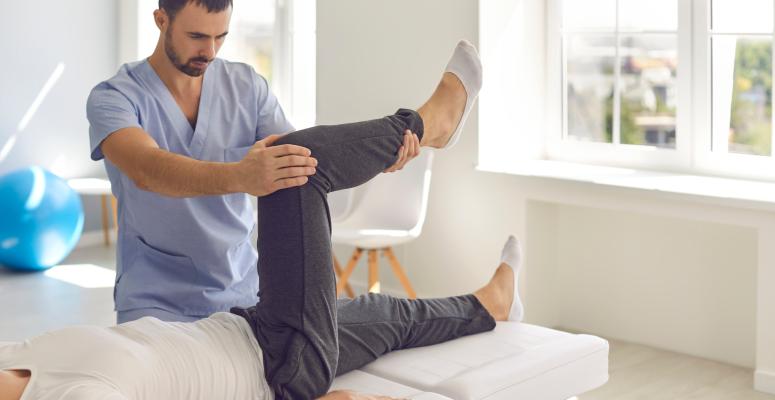
When your knee feels tight, it can make every physical task difficult and even painful. Even trying to walk from one place to another with a tight and stiff knee can be a struggle. By learning about the cause behind the tightness in your knee, you can figure out the best way to treat it.
Physical therapy is one of the most effective treatment options for pain in almost every area of the body, including the knee. When you’re experiencing painful tightness in your knee, you don’t have to just grin and bear it. Physical therapy can help alleviate the pain and restore your knee’s mobility.
Read on to learn about the commonality of knee pain, possible reasons why your knee is feeling tight and how physical therapy can help.
How common is knee pain?
When people talk about tightness in their knee, they’re usually referring to knee pain.
It’s not uncommon to experience knee pain and stiffness from time to time. In fact, knee pain affects about 25% of all adults and accounts for almost 4 million primary care physician appointments every year.
Knee pain is often combined with other symptoms of knee problems, such as:
- Reduced range of motion.
- Swelling.
- Instability and weakness.
- Crunching or popping sounds with movement.
5 potential causes for knee tightness
Sometimes your knee can feel tight for a bit after sitting in the same spot for a while or kneeling down for an extended period of time. But there are other causes that shouldn’t be brushed off. Many reasons for tightness in your knee stem from an injury or a medical condition. By exploring each one, you can see which one aligns best with your symptoms.
Here are five of the most likely reasons for your knee tightness:
- ACL injury — If you’ve sustained trauma to the knee or a sports injury, it’s possible to tear or sprain your anterior cruciate ligament, commonly known as the ACL. This ligament is made up of tissue that connects your shinbone to your thighbone. Injuring your ACL can cause painful knee tightness as well as instability and swelling.
- Meniscus tear — A meniscus is a piece of cartilage that works as a shock absorber between your thighbone and shinbone. You have two menisci in each knee, and they can be torn if you twist your knee with force or put too much pressure on the joint. A torn meniscus usually occurs while playing sports or exercising.
- Muscle imbalance — If you have some muscles around your knee that are stronger than others, such as your hamstrings or calves, there can be too much pressure placed on the joint and attached tendons. A muscle imbalance can be caused by favoring certain muscle groups during exercises or doing repetitive movements.
- Tendinitis — Tendinitis in the knee refers to patellar tendinitis, which means inflammation of the tendon that attaches your patella (kneecap) to your shinbone (tibia). It’s an overuse knee injury that can cause tightness, pain and swelling. It’s especially common in athletes who jump a lot, such as basketball players.
- Arthritis — Since the knee is the largest joint in your body, it’s a common location for joint inflammation or arthritis. Rheumatoid arthritis or osteoarthritis can both cause knee tightness. While rheumatoid arthritis damages the lining of your joint, osteoarthritis causes cartilage to erode.
How physical therapy can help treat tightness in your knee
If the tightness in your knee is interfering with your quality of life, then it’s important to explore potential treatment options. Physical therapy techniques, like manual therapy and exercises, are an effective course of action for helping treat knee pain as well as increasing its strength, flexibility and mobility.
When it comes to alleviating tightness and pain in your knee, a physical therapist will likely use manual therapy to reduce the tension that’s trapped in the soft tissue. One technique they might utilize is soft tissue mobilization, which involves them using their hands to move around the joint and find the restrictive tissue. Then they can use massage-like movements to apply pressure to the tissue and release the painful tension.
Targeted exercises can help improve your knee’s overall function to reduce the risk of future injury or pain. Your physical therapist will walk you through exercises that will strengthen the muscles surrounding your knee to decrease the stress placed on the joint and provide support while you stand and move. Stretching exercises can also increase the knee joint’s range of motion by reducing the tightness.
Alliance PTP is ready to help you find a caring partner to address your knee issue
Even though there are many potential reasons that you’re experiencing tightness in your knee, physical therapy can help restore your mobility as well as keep your knee strong and flexible for the future.
Need a partner to help you address your knee tightness? Alliance Physical Therapy Partners is here for you.
We can help you find the in-person or virtual physical therapy that’s right for you, and even better, we’ll help you find a team of caring professionals who are ready to walk with you through your entire PT journey.
Contact us today to start getting the care you need.
Get Help at a Location Near You
